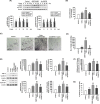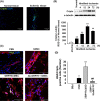Administration of Cripto in GRP78 overexpressed human MSCs enhances stem cell viability and angiogenesis during human MSC transplantation therapy
- PMID: 29722092
- PMCID: PMC6528945
- DOI: 10.1111/cpr.12463
Administration of Cripto in GRP78 overexpressed human MSCs enhances stem cell viability and angiogenesis during human MSC transplantation therapy
Abstract
Objectives: The purpose of this study was to explore the effectiveness of concurrent GRP78 overexpression combined with Cripto on hMSC proliferation and migration both in vitro and in vivo. Specifically, we explored whether the treatment enhances effectiveness of hMSC transplantation in ischaemic tissue.
Materials and methods: Human MSCs obtained from human adipose tissue were cultured in α-minimum essential medium (Hyclone, Logan, UT, USA) supplemented with 10% (v/v) foetal bovine serum (Hyclone), 100 U mL-1 penicillin and 100 μg mL-1 streptomycin. Murine hindlimb ischaemic model was generated with 8-week-old male nude BALB/c mice (Biogenomics, Seoul, Korea) maintained under a 12-h light/dark cycle following the established protocol with minor modification. Cellular injection was performed no later than 3 hour after surgery. Lipofectamine transfection, single-cell cultivation assay, transwell assay, scratch wound-healing migration assay, immunohistochemistry and western blotting assays were performed.
Results: Overexpression of GRP78 along with Cripto enhanced hMSC proliferation, migration and invasion. It increased interaction of surface GRP78 receptor with Cripto via JAK2/STAT3 pathway. We confirmed our proposed mechanism by showing that treatment with GRP78 antibody blocks the enhancement in vitro. In vivo, we observed that Cripto induced by the hypoxic environment in hindlimb ischaemic model interacts with the overexpressed GRP78 and increases hMSC proliferation, migration and invasion potentials as well as angiogenesis around transplanted ischaemic site via cytokine secretions.
Conclusions: These results demonstrate supporting evidences that GRP78-Cripto combination technique offers novel strategy to enhance MSC proliferation, migration and invasion potentials as well as angiogenesis around ischaemic site, ultimately facilitating MSC-based transplantation therapy in ischaemic conditions.
Keywords: Cripto; GRP78; angiogenesis; cell proliferation; invasion; mesenchymal stem cells.
© 2018 John Wiley & Sons Ltd.
Conflict of interest statement
The authors declare no conflict of interest.
Figures






Similar articles
-
Hypoxic Preconditioning Promotes the Bioactivities of Mesenchymal Stem Cells via the HIF-1α-GRP78-Akt Axis.Int J Mol Sci. 2017 Jun 21;18(6):1320. doi: 10.3390/ijms18061320. Int J Mol Sci. 2017. PMID: 28635661 Free PMC article.
-
CRIPTO and its signaling partner GRP78 drive the metastatic phenotype in human osteotropic prostate cancer.Oncogene. 2017 Aug 17;36(33):4739-4749. doi: 10.1038/onc.2017.87. Epub 2017 Apr 10. Oncogene. 2017. PMID: 28394345 Free PMC article.
-
CRIPTO/GRP78 signaling maintains fetal and adult mammary stem cells ex vivo.Stem Cell Reports. 2014 Apr 3;2(4):427-39. doi: 10.1016/j.stemcr.2014.02.010. eCollection 2014 Apr 8. Stem Cell Reports. 2014. PMID: 24749068 Free PMC article.
-
Hematopoietic stem cells are regulated by Cripto, as an intermediary of HIF-1α in the hypoxic bone marrow niche.Ann N Y Acad Sci. 2012 Aug;1266:55-62. doi: 10.1111/j.1749-6632.2012.06564.x. Ann N Y Acad Sci. 2012. PMID: 22901256 Review.
-
Cripto/GRP78 modulation of the TGF-β pathway in development and oncogenesis.FEBS Lett. 2012 Jul 4;586(14):1836-45. doi: 10.1016/j.febslet.2012.01.051. Epub 2012 Feb 1. FEBS Lett. 2012. PMID: 22306319 Free PMC article. Review.
Cited by
-
Whence CRIPTO: The Reemergence of an Oncofetal Factor in 'Wounds' That Fail to Heal.Int J Mol Sci. 2021 Sep 21;22(18):10164. doi: 10.3390/ijms221810164. Int J Mol Sci. 2021. PMID: 34576327 Free PMC article. Review.
-
Natural Products in the Prevention of Metabolic Diseases: Lessons Learned from the 20th KAST Frontier Scientists Workshop.Nutrients. 2021 May 31;13(6):1881. doi: 10.3390/nu13061881. Nutrients. 2021. PMID: 34072678 Free PMC article. Review.
-
Gastric Cancer Cell-Derived Exosomal GRP78 Enhances Angiogenesis upon Stimulation of Vascular Endothelial Cells.Curr Issues Mol Biol. 2022 Dec 6;44(12):6145-6157. doi: 10.3390/cimb44120419. Curr Issues Mol Biol. 2022. PMID: 36547080 Free PMC article.
-
MiR-138-1-3p alters the stemness and radiosensitivity of tumor cells by targeting CRIPTO and the JAK2/STAT3 pathway in nasopharyngeal carcinoma.Ann Transl Med. 2021 Mar;9(6):485. doi: 10.21037/atm-21-521. Ann Transl Med. 2021. PMID: 33850882 Free PMC article.
-
Is there a place for mesenchymal stromal cell-based therapies in the therapeutic armamentarium against COVID-19?Stem Cell Res Ther. 2021 Jul 27;12(1):425. doi: 10.1186/s13287-021-02502-7. Stem Cell Res Ther. 2021. PMID: 34315546 Free PMC article. Review.
References
-
- Nakagami H, Maeda K, Morishita R, et al. Novel autologous cell therapy in ischemic limb disease through growth factor secretion by cultured adipose tissue‐derived stromal cells. Arterioscler Thromb Vasc Biol. 2005;25:2542‐2547. - PubMed
-
- Vaananen HK. Mesenchymal stem cells. Ann Med. 2005;37:469‐479. - PubMed
-
- Phinney DG, Prockop DJ. Concise review: mesenchymal stem/multipotent stromal cells: the state of transdifferentiation and modes of tissue repair–current views. Stem Cells. 2007;25:2896‐2902. - PubMed
-
- Potapova IA, Gaudette GR, Brink PR, et al. Mesenchymal stem cells support migration, extracellular matrix invasion, proliferation, and survival of endothelial cells in vitro. Stem Cells. 2007;25:1761‐1768. - PubMed
-
- Andrades JA, Han B, Becerra J, Sorgente N, Hall FL, Nimni ME. A recombinant human TGF‐beta1 fusion protein with collagen‐binding domain promotes migration, growth, and differentiation of bone marrow mesenchymal cells. Exp Cell Res. 1999;250:485‐498. - PubMed
MeSH terms
Substances
Grants and funding
LinkOut - more resources
Full Text Sources
Other Literature Sources
Medical
Miscellaneous

